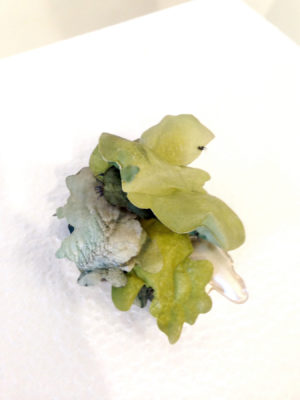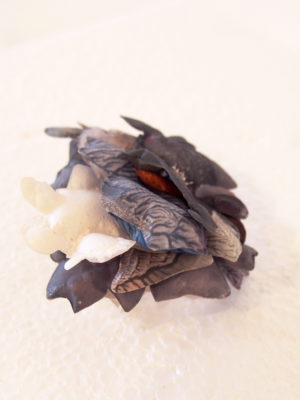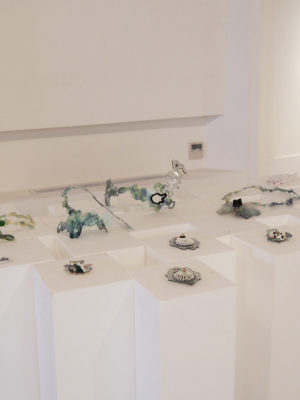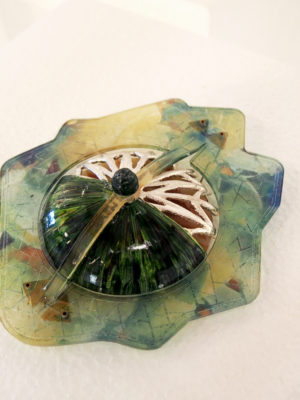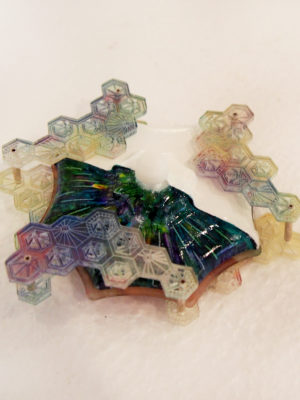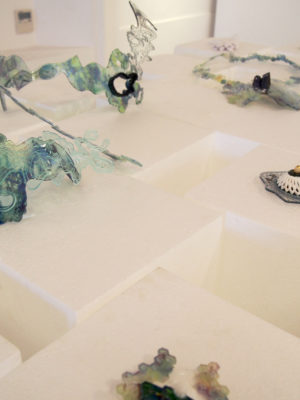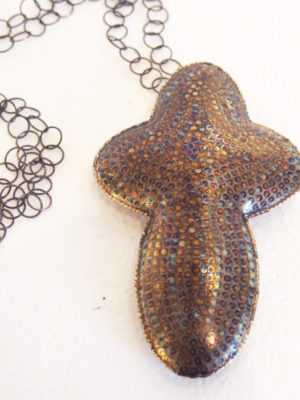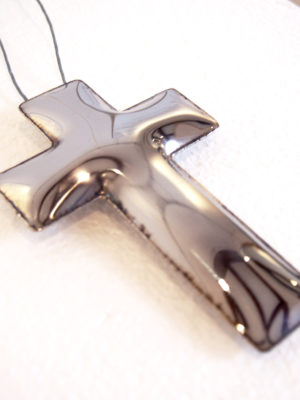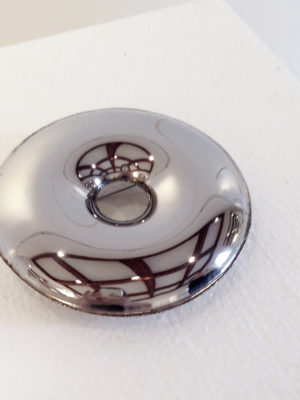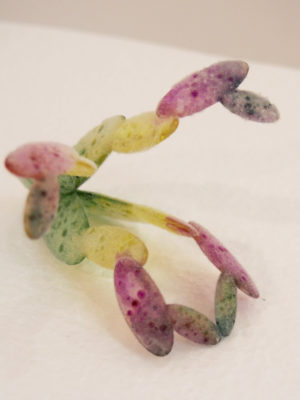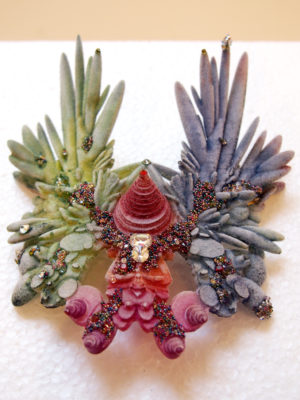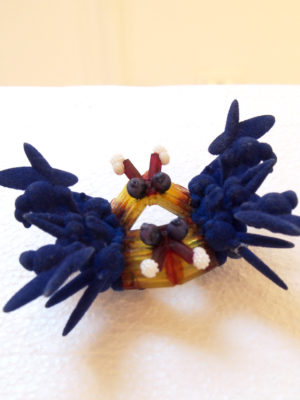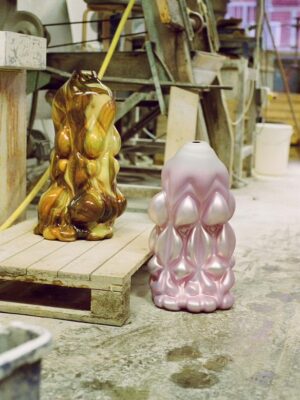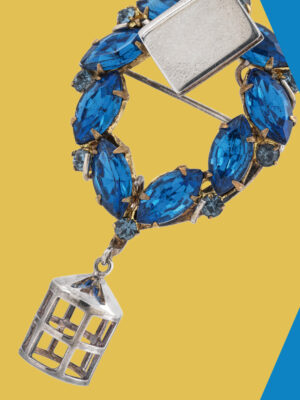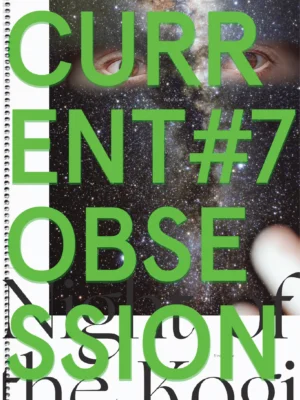In an age of image oversaturation, almost the third decade of the internet, and wanting to be different than their peers within that landscape, these young artists are asked to respect tradition while feeling the pressures of new technologies – and meanwhile, are just starting to confront the nostalgia of a simpler time before the promises of the new millennium.
Is the result jewellery as hyperrealism? In these extraordinary cases, the jewel has become secondary to itself, leading instead with the feats of its own makeup and the circumstances of its existence. It is jewellery augmented; it has become cyborg – a futuristic, advanced simulation of something all too familiar.
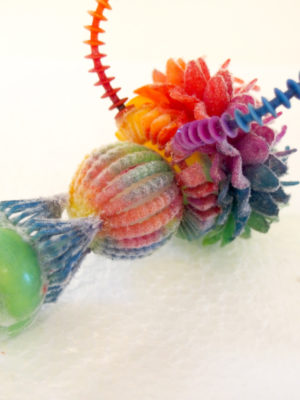
Kellie Riggs: How did you enter the jewellery making world, and why was it artistic jewellery that you were drawn to?
Qian Wang: I followed my fate… I have to say I inherited the craftsmanship from my family. I was born into a family that owned a small machinery plant. I began to develop my fascination in jewellery and a strong hands-on ability at a young age. I remember well this one time I made earrings with scrap metal from the lathe when I was a kid. Later, I studied with professor Jivan, who showed me a different view, that contemporary jewellery was more open. The mixed materials, the various techniques, critical thinking, and deep research were all things that made me want to dive deep into the field.
Xiaodai Huang: At university, I first entered the School of Design, which is divided into seven different professions of design categories, among which there is jewellery. I had carefully thought about my own life experience and felt that I had been very interested in jewellery. I always enjoyed the three-dimensional stuff, like makings things by hand. Among the seven professions in the School of Design, in my opinion, contemporary jewellery design was the closest to art, and it is also overarching. At the same time, it involves a lot of materials and has personal expression of emotion, without many restrictions. This is also one reason that I’m attracted to jewellery design, as it has a lot of room to develop.
Fang Yin Yeh: I was inspired by Shirley Ke, experimenting with the combination of various materials and metals, and drawn to the jewellery making world.
Sachar Cohen: It was actually kind of an accident. I entered jewellery and fashion at Bezalel Academy of Arts and Design in Jerusalem but I wasn’t sure what I wanted to, I was actually more interested in fashion at the beginning. After a year and a half jewellery made the most sense because it came easy, so I continued with it. The artistic point of view came afterwards. At first it wasn’t about expressing myself, it was just about making. I was there from 2006 to 2010, and came to the academy in Munich in 2013. Everything is so closed in Israel, and I didn’t know what was going on with contemporary jewellery abroad. I literally didn’t know anything. I didn’t know of Alexander Blank, for example; Attai Chen studied at the Munich Academy so that’s how I heard about it, and of course Otto Künzli, but that was it.
KR: Do you as a maker in some way feel stuck between the pressures of following the rules of jewellery tradition (technique, material etc), and the pursuit of new technologies?
QW: Why I should follow the rules of traditional technique or material? Why can’t I do something more creative with my work? My answer is yes, in that I prefer more creative activities, in whatever the medium is, technique or material. So I don’t think there is pressure. On the contrary, I am interested in challenge of new technology, because new materials make me excited.
XH: Sometimes I can recognize some restrictions that come from the craft of jewellery, as well as the deviations and restrictions in the process of software implementation. But other times I can use the maximum space caused by these restrictions to achieve my own ideas. Scientists and other artists in different fields have always explored new materials and crafts. And how to get these things involved in the field of jewellery is also one of my current concerns.
FYY: Jewellery creation is very interesting to me, and I do not feel the pressure of the traditional technology. I cannot say that I use materials no one else is using, but I try to use them in my own way to express the characteristics of the material differently.
SC: For me, everything was more about concept in the beginning. Of course it’s always interesting to find a new technology or material, to be innovative. But on the other hand it’s even harder to do something new and be surprising WITH the traditional techniques. Basically everything has been done. So this is exactly the point that is more interesting to me – how you can be innovative within tradition. I’m doing this press forming with stainless steel, which is much easier than non-ferrous metals because you don’t have to make the material soft before. It’s quicker that way. And then the welding of course is “relatively new” in jewellery, but not new at all. I chose welding to construct the pieces because it would be a nightmare to solder the steel. So it’s all practical. In the conception of my work it’s more about the form. The form is what takes me time, to find the right from in 2D and then to translate that into 3D.
KR: Where would you place yourself on a scale from 1 – 10, 1 being a traditional goldsmith, and 10 being quite the opposite in your approach to making jewellery?
QW: I don’t like to be classified by working in one specific area. I think my pieces are the perfect example in explaining this because they contain goldsmithing skills alongside new innovations in material to interpret my subject matter. During my experiments, I have tried several types of materials like resin, glass, acrylic, Polypropylene and types of metal which also coordinate with the techniques like thermal transfer of the colour pattern, the forming of acrylic objects, and laser cutting of the acrylics.
XH: I think the ratio should be around 7-8, because I have been trying to use the computer modelling to make jewellery differently from the traditional goldsmith who engraves or constructs with metal, but I also have learned all the skills from traditional goldsmithing, so I cannot be objective enough to describe which side I am more inclined to.
FYY: I am not sure because I tend to use 50% metal and 50% paper in my work… making them mimic the appearance of each other is my favourite aspect of my process.
SC: Does traditional goldsmithing mean doing more commercial work? I think what I do would change a lot if it were in gold, and it would be amazing if I could do it. But I don’t have the money for it and maybe people wouldn’t have the money to buy it, but if you think about having your reflection in gold —- amazing.
But traditional goldsmithing is not a necessity in our time. Sure it can help you – help you make good finishes on brooches, but is it a necessity? No, not at all. You can make amazing works without knowing traditional goldsmthing. It helps me, yes, it’s my education because I studied to be a goldsmith and it’s what I know to do. Look at Lisa Walker. She knows too, but she doesn’t do it. It’s a cliché maybe, but it’s true. I’m not giving you a number.
KR: What do you feel the role jewellery plays in culture? Youth culture, your own local culture… or do you try to cultivate a cultural context around your work?
QW: I believe the boundary between jewellery and other art genres has been breaking. For me, the jewellery is an intermediary to demonstrate the garden landscapes and historical meanings in there that I’m interested in. The jewellery concentrates all the features from architecture, sculpture, visual art and craft into one object, that then is presented on the human body. This responds to my personal point of view in the topic of culture.
XH: I think the role of jewellery is indispensable in culture. Since the ancient times, jewellery has been around, and it has its own indispensable role in the long history of human beings. Although it may occupy only a small part, it has many cultures to explore. I am from China – there are many changes of dynasties in China’s history of the past few thousand years, as well as different styles of jewellery standing for each dynasty. Standing in such a rich historical and cultural background, I learn from it as much as possible. Taking advantage of it, I create my own works from that essence.
SC: Obviously jewellery was always about culture. If it’s political, spiritual, if it’s economical, if it’s whatever it is. You cannot disconnect jewellery from culture. Most people don’t think about it, but it’s there. Jewellery is the first method of expression – the most primitive way of expressing your point of view. The direction I take in my work was always grounded in culture.
KR: Do you think that the definition of the word ‘craft’ should start to include some of the new technologies being used to achieve contemporary works in jewellery? Do you find craft to be a flexible term where you come from?
QW: According to the definition, a craft is a pastime or a profession that requires particular skills and knowledge of the skilled work. The word is a historic term, so it should be developing with the times. The Chinese government is trying to revive traditional craft with a program that protects intangible cultural heritage. Some measures are being taken to develop the craft culture and new views on craft as well.
XH: I think “craft” can cover a many number of directions, like works in jewellery. Otherwise, there could be a new word to define it, and I think it may be a means of implementation. It is well-known that many artists are exploring new production methods and a variety of technologies for their own creations.
SC: Where I come from it was never just about the making. It was always connected to what you think and what you do. So it’s not something separate by just the making. We have the word – but as I said if you say craft in Israel it means something that you do, that you also think about. It’s not separated from art, or from thinking, and it’s not thinking about how to do it or which techniques I need to use to make things.
KR: What is your personal definition of ‘hand-made’?
QW: I respect handmade pieces because they are related to delicate fine workmanship and traditional craft. But the definition of handmade is quite wide; you can enjoy some brilliant metalsmithed pieces with contemporary forms and textures. So, I insist that the concept of ‘handmade’ should add some modifier such as traditional or contemporary, in order to better define its extended meanings.
XH: It must have an individual identity to take part in. Other than the large-scale production of industrial machinery, there must be a similar behaviour of craftsmanship involved.
FYY: For me, it’s that all the details of the work are made with both hands. Something hand-made can be an accurate and direct outcome of an idea, from brain into object. Relatively though, the hand may have some chance of accidental error, which I think it is very valuable.
SC: Maybe now we can think about if there is a separation between handmade and manmade?
KR: From the following words, which one is the most relevant to you and your jewellery, and why?
nostalgia – hyper-realism – reflection – fantasy
QW: From my personal perspective, I choose nostalgia. No one can deny the emotion of nostalgia. I always ask myself why I have passion for this word. After deep consideration, I realized that I am a classic romantic person, full of confidence and passion about different details of culture. As we understand that jewellery is no longer just standing in for status, I hope the wearers will interact with my work differently.
XH: Reflection. I always think of myself as a social person in the world. Regardless of my profession and status, I hope that my works must contain in-depth thinking and judgment. At the same time, I also make continuous reflection on my works, and I hope that my works can present some issues, and then deliver some tips to the viewers.
FYY: 40% nostalgia, 60% reflection. The jewellery is full of my personal shadow, it is made to reflect my inner nostalgia.
SC: Reflection, because it’s literally the most important aspect of my work at the moment. Maybe it’s dull but everything is about surfaces, or the source of your work, and what generally comes to the surface. Of course it was always about looking up to your idol, whatever it is, which is always about wanting to be them in a way – but something you’ll never achieve. It’s just unreal.
KR: Can you briefly summarize what your jewellery is about, or the feelings you’d like to evoke in the wearer?
QW: The focus of my design work is to transform the similarities and differences between eastern and western gardens and translate that into my pieces. My design is based on the classic Versailles garden in France and the Suzhou garden in China; I rediscover the interesting visual experiences of both places and insert that into my work.
XH: My work that was on display at Preziosa is the study of the surrounding bio-mutation characters, based on the environmental damage after the leak of Fukushima nuclear power plant in Japan. According to the refined bio-mutations, I have created a series of creatures of unknown areas, in order to alert the viewers, and the work is expected to raise concerns about environmental issues. I hope that the wearer can feel concerned about environmental problems rather than just thinking it looks good.
FYY: Thin, fragile, emotional, life. Life is not eternal, life is fragile.
SC: Authenticity. It’s about what’s on the table. What you see is what is interesting to me. Can I wear it? Yeah of course, but also someone can simply look at it and take something from it, too.
KR: Why does jewellery matter to you, and how does your own work relate to those reasons?
QW: I am interested in contemporary art, craft and people. Contemporary jewellery is a good medium to approach my own ideas.
XH: For me, jewellery is a career that I will not give up in my life, and I really love it. When I see all the things related to jewellery, I feel very excited. And I may have the occupational disease mentioned by many people. That is, when I look at a person I will firstly look at her or his jewellery. In fact, I use my jewellery works to deliver my own ideas, and use jewellery to train my design thinking. In the process of learning jewellery design, I have also learned some news ways to create in general.
FYY: Making jewellery really is a treat for me; it lets me relax my mood in a busy life.
SC: I don’t think jewellery is really that important to me. I have to say, really, I can understand its importance, but I’m just making it. This is my medium of expressing myself. Who doesn’t have a piece of jewellery that isn’t important? Things I got from my grandfather, golden rings, I think it would be the worst thing that could happen to me if I lost them or someone stole them. But at the end of the day, if you want to make a change, there are so many other efficient ways other than jewellery to do something. I just make jewellery because I’m lucky, or privileged.
KR: Who is your jewellery for, ideally? Or if you could choose one living person to wear your jewellery, who would it be and why?
QW: My pieces are typically worn by males in my photos. I do this based on this conception that jewellery belongs to women in general. However, men are strong and powerful typically – in Chinese cultures, people believe in harmony. So the man wearing the jewellery is a balance of softness and hardness.
XH: In ideal conditions, I hope that those who are very responsible and able to think about the common concerned issues among human beings can wear my works. If possible, the relevant person may be in charge of the Nature Conservancy (TNC), because their background is in the protection of the environment and nature. I’d love for someone like this to call on and wear my works, maybe it can better deliver the ideas behind it.
FYY: My jewellery is my soul mate. It’s the twin of my mind’s thoughts. And it is for my mother, because she created me, and I created the jewellery.
SC: There is no such person. It’s you and it’s me, it’s whoever. It’s everybody. Just give me the cash, I don’t care who you are.
These four artists were selected from 185 worldwide applicants, by jurors Petra Hölscher (senior curator Die Neue Sammlung – The Design Museum, Germany), Inger Wästberg (art historian and curator, Sweden), Martina Dempf (anthropologist, goldsmith, art gallerist in Germany), Antonella Villanova, gallerist, Italy), Maria Cristina Bergesio (art jewellery historian and curator, Italy) & Francesca Mercanti (blogger in Italy). The exhibition took place on May 24-28 at Palazzo Coveri Gallery, Florence, Italy.
For this particular piece, Shachar Cohen was interviewed in person in Florence while the other three responded via email.
Introduction to series:
Florence, Italy, isn’t usually synonymous with contemporary anything – and despite its appreciation for the handmade, and its long history of being an important town for jewellery and goldsmithing (think Ponte Vecchio), contemporary jewellery rather, is still an off-the-beaten path anomaly. But for the last few years, for five days in late spring, it attempts to become Florence’s main attraction via Florence Jewellery Week.
Since 2005 Le Arti Orafe has been presenting PREZIOSA – a cultural initiative with contemporary jewellery at its focus. In 2008 PREZIOSA Young was introduced as well in order to promote the work of talented emerging makers in jewellery. And in recent years LAO’s ambition has expanded even further under the umbrella of FJW. As such, the project has been able to extend their programming that this year involved a two day conference with ten speakers, seven separate exhibitions, four jewellery workshops, various receptions and concerts, and the participation of three independent studios of LAO alumni.
The interview above is part of a short interview series (commissioned by LAO) that aims to shed light on the perspectives of seven of this year’s participants chosen by the author: Curators Kevin Murray and Inger Wästberg, artist Arata Fuchi, and this year’s four PREZIOSA Young winners, Qian Wang, Xiaodai Huang, Fang Yin Yeh, and Shachar Cohen.

